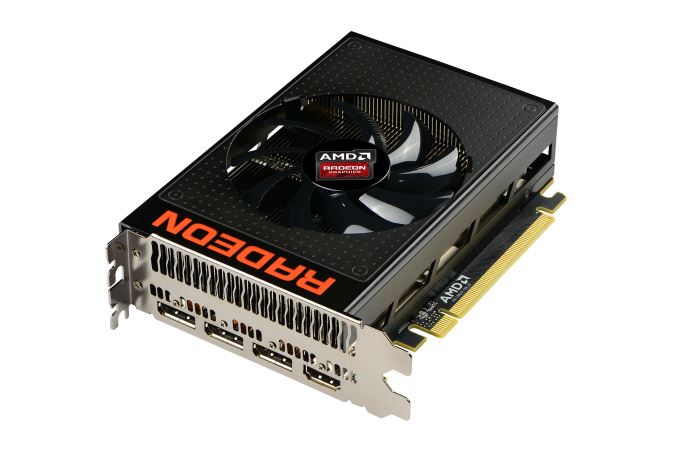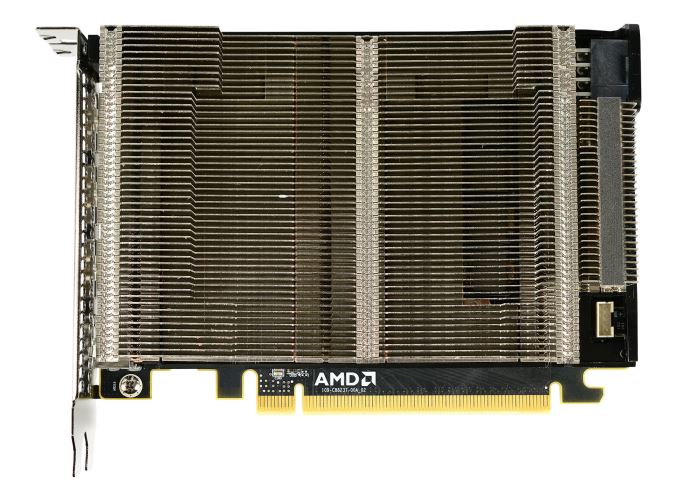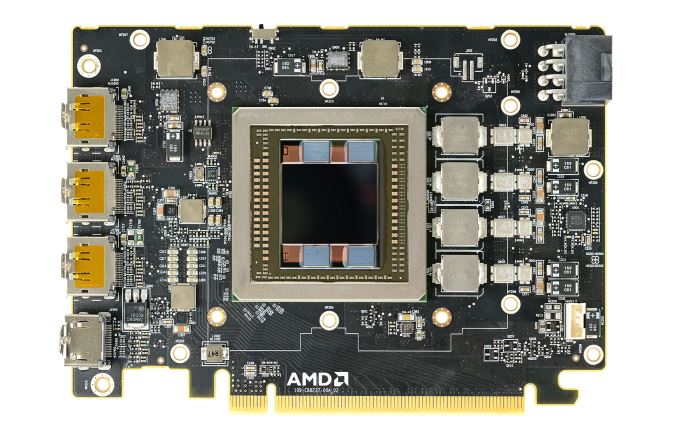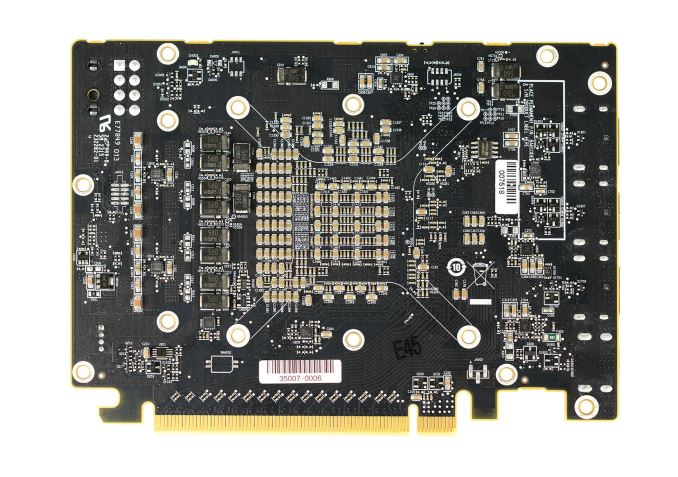The AMD Radeon R9 Nano Review: The Power of Size
by Ryan Smith on September 10, 2015 8:00 AM ESTMeet The Radeon R9 Nano
6 inch video cards are by no means a new thing in the GPU space, however these are traditionally lower-end products that need neither a large cooler nor an extensive power delivery system. As a result the R9 Nano is something of an interesting aberration, packing a lot more power and a lot more technology into half a foot of video card than what we normally see.
Starting as always from the top, the R9 Nano measures 6” long, which is actually a bit shorter than the full length the Mini-ITX standard allows. Responsibility for cooling the card falls to the R9 Nano’s new open air cooler, an aggressive design that has been specifically tailored to allow the card to effectively dissipate 175W of heat in such a small space.
The overall design of the R9 Nano’s cooler is best described as a combination open-air and half-blower hybrid. The design is technically open-air, employing a single axial fan to cool the card. However with only a single fan AMD has been able to align the heatsink fins horizontally and then place the fan in the center of the heatsink. The end result is that roughly half of the heat produced by the card is vented outside of the case, similar to a full blower, while the other half of the heat is vented back into the case. This reduces (though doesn’t eliminate) the amount of hot air being recycled by the card.
The heatsink itself is composed of aluminum and runs virtually the entire length of the card. This is technical a two-piece heatsink, with the primary heatsink composing the bulk of the card, while a much smaller secondary heatsink it found towards the far end of the card and mounted on top of a heatpipe.
Drilling down, we find that the primary heatsink is fed by a combination vapor chamber and heatpipe design. A copper vapor chamber serves to draw heat away from the Fiji GPU and HBM stacks, and then heatpipes are used to better distribute heat to the rest of the heatsink. The use of a vapor chamber in the R9 Nano makes a lot of sense given the fact that vapor chambers are traditionally the most efficient heatsink base type, however the R9 Nano is also unique in that we typically don’t see vapor chambers and heatpipes used together. Other designs such as the high-end GeForce series use a single large vapor chamber across the entire heatsink base, so among reference cards at least the R9 Nano stands alone in this respect. In this case given AMD’s design goals for size and noise, a vapor chamber will play a big part in helping the small card effectively and quietly dissipate 175W.
As for the physical PCB itself, as we can see AMD made it a relatively packed card in order to get the R9 Nano down to 6 inches. Compared to the R9 Fury X reference board, the biggest change here is that AMD has removed a fair bit of power circuitry to save space. By our count there are 4 VRM phases to feed the Fiji GPU, as opposed to the 6 found on R9 Fury X. Power delivery is handled by a single 8-pin PCIe power socket, which is becoming increasingly common, replacing the 2x 6-pin setup for 150W-225W cards.
Meanwhile to further shrink the overall PCB footprint, AMD has moved some of the remaining power delivery circuitry to the back of the card. The front of the card still contains the inductors and heat-sensitive MOSFETs, while a number of capacitors are on the rear of the card (and is why you won’t find a backplate).
Finally, for display I/O R9 Nano is unchanged from R9 Fury X. This means we’re looking at a DVI-free design, with 3x DisplayPort 1.2 and 1x HDMI 1.4 port all along a single row of the I/O bracket. Buyers looking to put together HTPCs will want to be especially mindful of the HDMI 1.4 port; while it's not necessarily a deal-breaker, it does mean that the R9 Nano can't fully drive 4Kp60 TVs, which are slowly but surely becoming more common.
Overall AMD is rather confident in their design for the R9 Nano. The heatsink is built to efficiently dissipate more heat than the 175W the card requires (despite the small size), and as a result we never see the R9 Nano thermally throttle under normal operation. The card’s thermal throttle point is 85C, and in our testing the card never passed 75C, exactly as AMD promised us. What ends up limiting the R9 Nano’s performance then is exactly as expected: the power throttling.
















284 Comments
View All Comments
itproflorida - Friday, September 11, 2015 - link
"As these benchmarks are from single player mode" haha,Kutark - Thursday, September 10, 2015 - link
I think *overall* AMD has a win with this as they've found a market (albeit small) that they can fill with a product without competition.This does lead me to wonder, what can Nvidia do? We know maxwell 2 is a little more power efficient than fiji... could they do a similar binning and back a GM200 chip down a 100mhz or so at a 175w tdp and produce similar results in a similar sized package? I know the HBM makes it a bit easier for the small form factor, but i don't think people will cry over half an inch longer board for an nvidia card in the same market.
Peichen - Friday, September 11, 2015 - link
GTX980 is already a 175W card. Reference GTX980 have the same power plug requirement as the Nano.slapdashbr - Friday, September 11, 2015 - link
nVidia isn't pushing (as far as I know) any of it's AIB partners to do this, but: gigabyte could just make a gtx 980 on the same PCB as that 970 mini. The 980 only uses what, 165W? 180 maybe? it's roughly on par with the nano to be honest, and with the fairly low power draw I really don't see why you can't have a 980 on a shorter card. Honestly an ITX-size 980 was what I wanted as soon as they were announced, for god's sake, the r9-380 can draw more juice than a 980 and those are available in ITX form factor.Kutark - Friday, September 11, 2015 - link
Fair point. I still wonder though if they did a GM200, basically a 980ti thats backed down on clock rates to meet a lower TDP, what it would look like.medi03 - Saturday, September 12, 2015 - link
There is more to it: that HBM memory thing allows for more compact designs.extide - Monday, September 14, 2015 - link
Well yeah, but there are already ITX sized cards out there with GDDR5 (GTX 970, R9 380, etc) so it's obviously possible. PCB might be a little bit bigger but it can still be ITX sized.Kutark - Wednesday, September 30, 2015 - link
Not *that* much more compact. From what i understand we're talking about half an inch or so shorter because of the HBM.Jm09 - Thursday, September 10, 2015 - link
I wish amd would of released a nano and a nano-x with this choice being the nano x as its a binned full Fiji chip. I think an r9 nano competing in the $400 range would of been a huge hit, and raise brand perception which amd needs a ton of right now.Peichen - Friday, September 11, 2015 - link
Nano is the full chip. It just runs at a lower clock than Fiji X and Fiji, the actual trimmed card.